Sam Ash Music ST5 Wireless Microphone User Manual Stage5 55 ownman 2
Sam Ash Music Corporation Wireless Microphone Stage5 55 ownman 2
Users Manual Revised
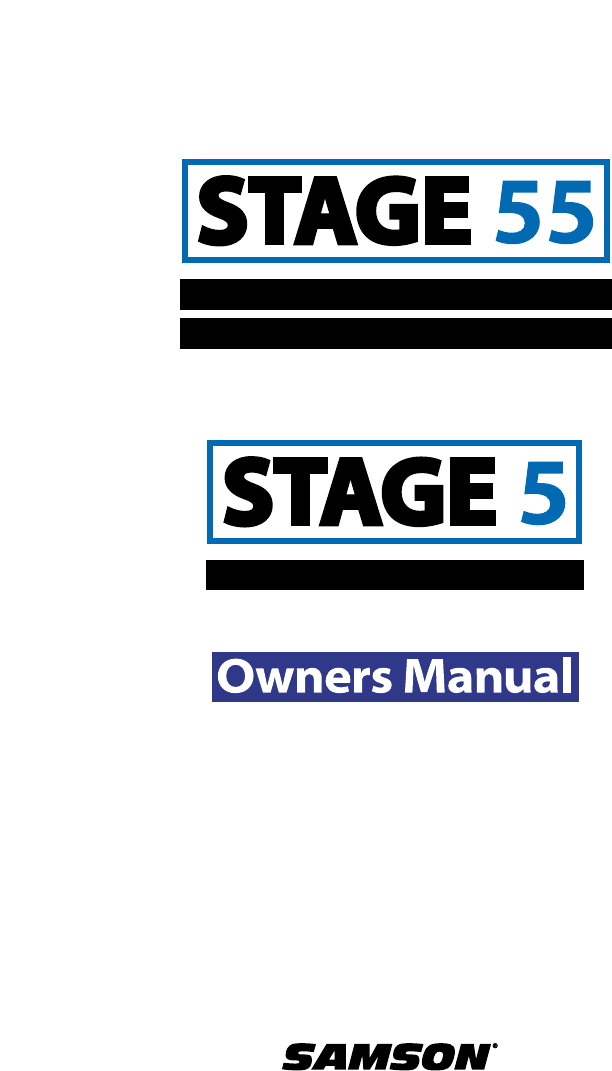
WIRELESS
AND
WIRELESS SYSTEM
TRUE DIVERSITY
WIRELESS SYSTEM

Copyright 2002, Samson Technologies Corp.
Printed September 2002
Samson Technologies Corp.
575 Underhill Blvd.
P.O. Box 9031
Syosset, NY 11791-9031
Phone: 1-800-3-SAMSON (1-800-372-6766)
Fax: 516-364-3888
Table of Contents
Introduction 3
Guided Tour - SR55 Receiver Front Panel 5
Guided Tour - SR55 Receiver Rear Panel 6
Guided Tour - SR5 Receiver Front Panel 7
Guided Tour - SR5 Receiver Rear Panel 8
Guided Tour - ST5 Transmitter 9
Guided Tour - HT5 Transmitter 11
Setting Up and Using Your Stage 55 Series / Stage 5 Series System 12
Appendix B: Carrying Case 15
Specifications 16

3
Introduction
Congratulations on purchasing the Samson Stage 55 Series or Stage 5 Series Wireless
System! Although this product is designed for easy operation, we suggest you first take
some time to go through these pages so you can fully understand how we’ve implemented
a number of unique features.
Every wireless system consists of at least two components—a transmitter and a receiver,
both of which must be tuned to the same channel (that is, the same radio frequency) in
order to operate correctly.* The Samson Stage 55 Series or Stage 5 Series system you
have purchased operates in the 174.0 - 216.0 MHz frequency range and contains either a
SR55 or SR5 receiver as well as one of the following transmitters: a ST5 belt-pack
transmitter (for lavaliere microphone or headset applications); a ST5 belt-pack transmitter
(for instrument applications); or a HT5 hand-held microphone transmitter. For convenience
and security, the Stage 55 Series and Stage 5 Series system is packaged in a custom
impact-resistant polypropylene plastic carrying case that provides room for all components
(see Appendix B for more information).
The ST5L beltpack transmitter provides a locking 3.5 mm mini-phone jack for connection to
the various Stage series transmitters including:
LM5 - Lavaliere condenser microphone
HS5 - Headset condenser microphone
GC5 - Heavy-duty Guitar/Instrument cable
The HT5 hand-held microphone transmitter is equipped with the Samson Q7 neodymium
dynamic microphone element.
* Your receiver and transmitter have been factory preset to utilize the same channel.
The SR5 receiver provided with the STAGE 5 Series wireless system utilizes non-diversity
technology, incorporating a single antenna for ease of use and minimal cost. The SR55
receiver provided with the Stage 55 Series system utilizes an advanced technology
called “Diversity,” whereby a single chassis houses two antennas (called “Antenna A” and
“Antenna B”) and a receiver circuit. An advanced circuit design continuously scans RF sig-
nals from the two antennas and determines which one has the clearest and strongest
reception, automatically (and silently) switching that signal to the receiver. This allows you
to maintain the wireless communication link over a much broader area range than would be
allowed by a receiver utilizing a single antenna and also virtually eliminates multipath
dropouts, interference and phase cancellation problems. In addition, special sample-and-
hold linking circuitry ensures that correct phase correlation is maintained at all times, with
no noise or pops during antenna switching. The result is performance which exceeds that
of conventional non-diversity systems and the highest quality audio fidelity available in any
wireless system. Finally, the provision of a noise reduction circuit produces crystal-clear
sound with minimized background noise and hiss.

4
Introduction
In this manual, you’ll find a more detailed description of the features of your Stage 55
Series or Stage 5 Series system, as well as a guided tour through all components, step-
by-step instructions for setting up and using your system and full specifications. If your
Stage 55 Series or Stage 5 Series system was purchased in the United States, you’ll also
find a warranty card enclosed—don’t forget to fill it out and mail it! This will enable you to
receive online technical support and will allow us to send you updated information about
other Samson products in the future. If your Stage 55 Series or Stage 5 Series system
was purchased outside of the United States, contact your local distributor for warranty
details.
SPECIAL NOTE for U.S. purchasers: Should your Stage 55 Series or Stage 5 Series sys-
tem ever require servicing, a Return Authorization number (RA) is necessary. Without this
number, the unit will not be accepted. Please call Samson at 1-800-372-6766 for a
Return Authorization number prior to shipping your unit. Please retain the original packing
materials and, if possible, return the unit in its original carton and packing materials.
If your Stage 55 Series or Stage 5 Series system was purchased outside of the United
States, contact your local distributor for servicing information.
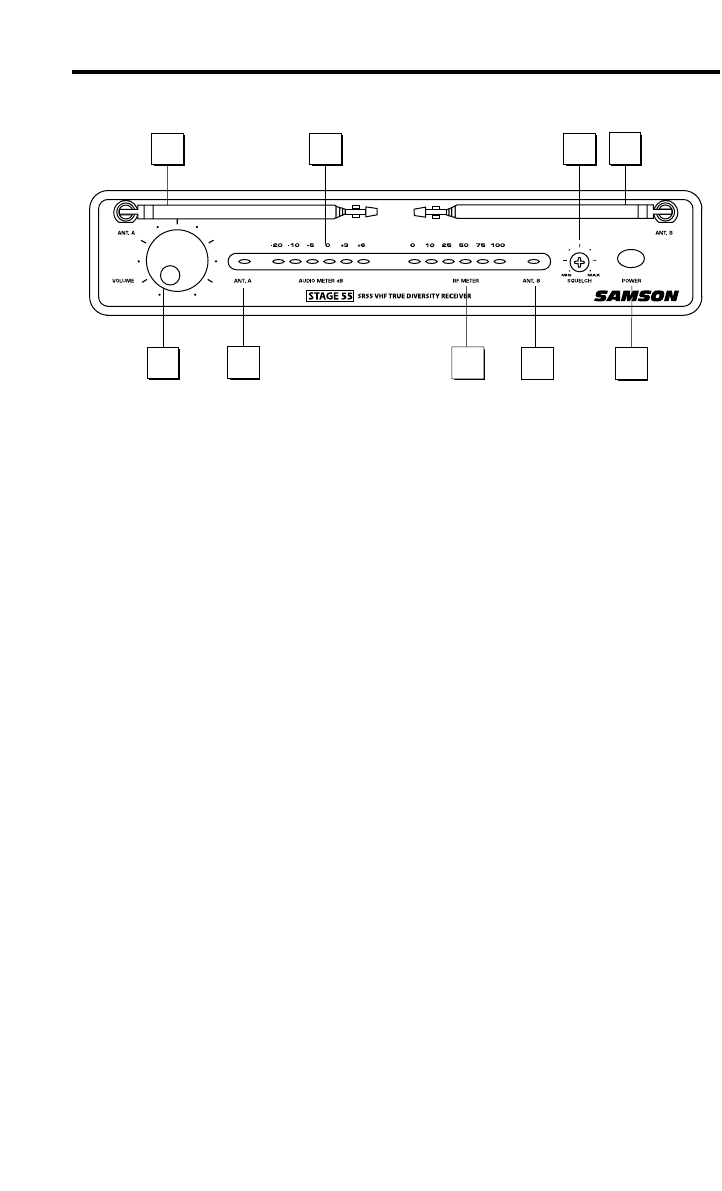
5
Guided Tour - SR55 Front Panel
1: Antennas (A and B) - The antenna mountings allow full rotation for optimum
placement. In normal operation, both Antenna A (the antenna on the left) and Antenna B
(the antenna on the right) should be placed in a vertical position. Both antennas can be
folded inward for convenience when transporting the SR55. See the “Setting Up and Using
Your Stage 55 Series / Stage 5 Series System” section on page 12 in this manual for more
information about antenna positioning.
2: Volume control - This knob sets the level of the audio signal being output through both
the balanced and unbalanced output jacks on the rear panel. Reference level is obtained
when the knob is turned fully clockwise.
3: Audio Meter - This “ladder” display (similar to the VU bar meter used on audio devices)
indicates the strength of the incoming audio signal. When the “0” segment is lit, the incom-
ing signal is optimized at unity gain; when the “+6” segment is lit, the signal is overloading.
When only the left-most “-20” segment is lit, the incoming signal is at just 10% of optimum
strength. If no segments are lit, little or no signal is being received. See the “Setting Up
and Using Your Stage 55 Series / Stage 5 Series System” section on page 12 in this manu-
al for more information.
4: Squelch control - This control determines the maximum range of the SR55 before
audio signal dropout. Although it can be adjusted using the supplied plastic screwdriver, it
should normally be left at its factory setting. See the “Setting Up and Using Your Stage 55
Series / Stage 5 Series System” section on page 12 in this manual for more information.
5: ANT A/B LEDs - When signal is being received, one of these will be lit yellow, showing
you whether the (left) “A” or (right) “B” antenna is currently being used. The SR55 con-
stantly scans its two antennas and automatically selects whichever is receiving the
strongest, clearest signal. This Diversity switching is completely inaudible, but it effectively
increases overall range while virtually eliminating potential interference and phase cancel-
lation problems.
6: RF Meter - This “ladder” display (similar to the VU bar meter used on audio devices)
indicates the strength of the incoming radio signal. When the “100%” segment is lit, the
incoming RF signal is fully modulated and at optimum strength. When only the second
most left-most “10%” segment is lit, the incoming signal is at just 10% of optimum strength.
If no segments are lit, little or no signal is being received. See the “Setting Up and Using
Your Stage 55 Series / Stage 5 Series System” section on page 12 in this manual for more
information.
7: Power switch - Use this to turn the SR55 power on and off.
1
2
3 4
5 5
1
7
6
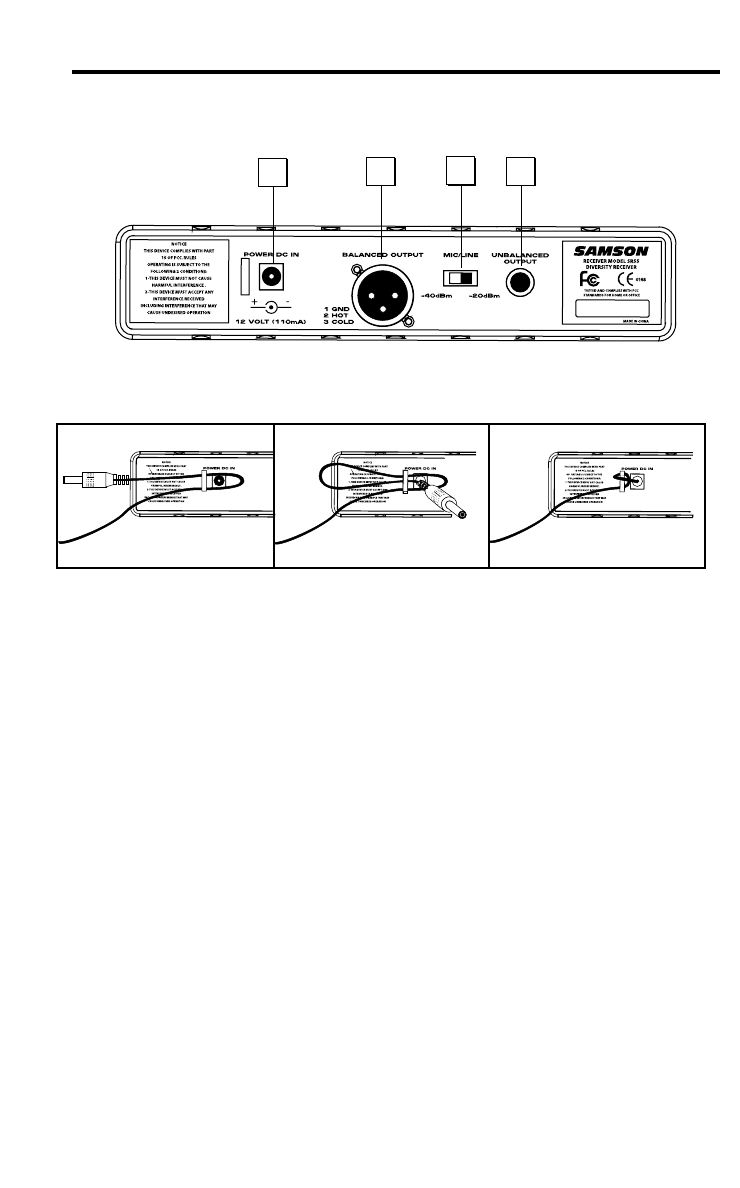
6
Guided Tour - SR55 Rear Panel
1: DC input - Connect the supplied 12 volt, 250 mA power adapter here, using the strain
relief as shown in the illustration below. WARNING: The substitution of any other kind of
power adapter can cause severe damage to the SR55 and will void your warranty.
2: Balanced output* - Use this electronically balanced low impedance (600 Ohm) XLR
jack when connecting the SR55 to professional (+4) audio equipment. Pin wiring is as
follows: Pin 1 ground (shield), Pin 2 high (hot), and Pin 3 low (cold).
3: Audio Output Level switch - Sets the audio output level attenuation of the balanced
output (see #4 below) to -20 dBm (line level) or -40 dBm (mic level). See the “Setting Up
and Using Your Stage 55 Series / Stage 5 Series System” section on page 12 in this manu-
al for more information.
4: Unbalanced output* - Use this unbalanced high impedance (5K Ohm) 1/4" jack when
connecting the SR55 to consumer (-10) audio equipment. Wiring is as follows: tip hot,
sleeve ground.
* If required, both the unbalanced and balanced outputs can be used simultaneously.
1234
-
Using the strain relief: Gather up a loop of wire and pass it through the strain relief,
then pass the adapter plug through the loop in order to create a knot.
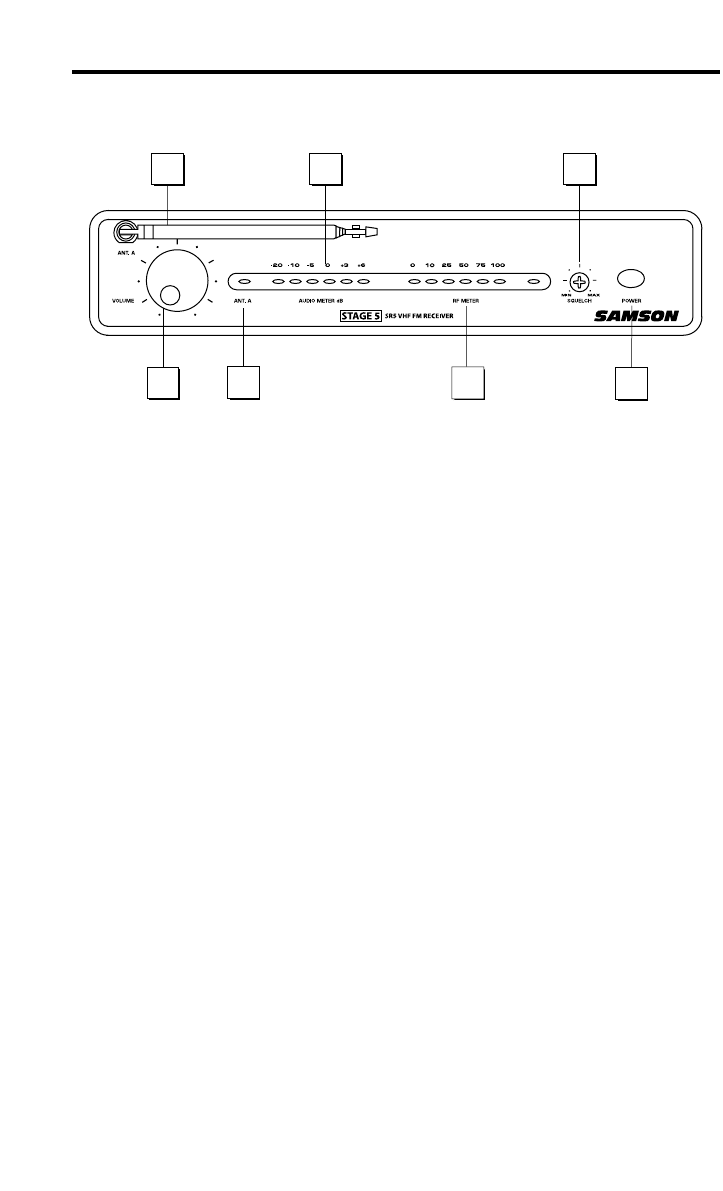
7
Guided Tour - SR5 Front Panel
1: Antenna - The antenna mounting allows full rotation for optimum placement. In normal
operation, the antenna should be placed in a vertical position. It also can be folded inward
for convenience when transporting the SR5. See the “Setting Up and Using Your Stage
55 Series / Stage 5 Series System” section on page 12 in this manual for more information
about antenna positioning.
2: Volume control - This knob sets the level of the audio signal being output through both
the balanced and unbalanced output jacks on the rear panel. Reference level is obtained
when the knob is turned fully clockwise.
3: Audio Meter - This “ladder” display (similar to the VU bar meter used on audio devices)
indicates the strength of the incoming audio signal. When the “0” segment is lit, the incom-
ing signal is optimized at unity gain; when the “+6” segment is lit, the signal is overloading.
When only the left-most “-20”segment is lit, the incoming signal is at just 10% of optimum
strength. If no segments are lit, little or no signal is being received. See the “Setting Up
and Using Your Stage 55 Series / Stage 5 Series System” section on page 12 in this manu-
al for more information.
4: Squelch control - This control determines the maximum range of the SR5 before audio
signal dropout. Although it can be adjusted using the supplied plastic screwdriver, it should
normally be left at its factory setting. See the “Setting Up and Using Your Stage 55 Series
/ Stage 5 Series System” section on page 12 in this manual for more information.
5: “TX” LED - Lights when carrier signal of sufficient strength is being received by the
SR5.
6: RF Meter - This “ladder” display (similar to the VU bar meter used on audio devices)
indicates the strength of the incoming radio signal. When the “100%” segment is lit, the
incoming RF signal is fully modulated and at optimum strength. When only the second
most left-most “10%” segment is lit, the incoming signal is at just 10% of optimum strength.
If no segments are lit, little or no signal is being received. See the “Setting Up and Using
Your Stage 55 Series / Stage 5 Series System” section on page 12 in this manual for more
information.
7: Power switch - Use this to turn the SR5 power on and off.
1
2
3 4
5 7
6
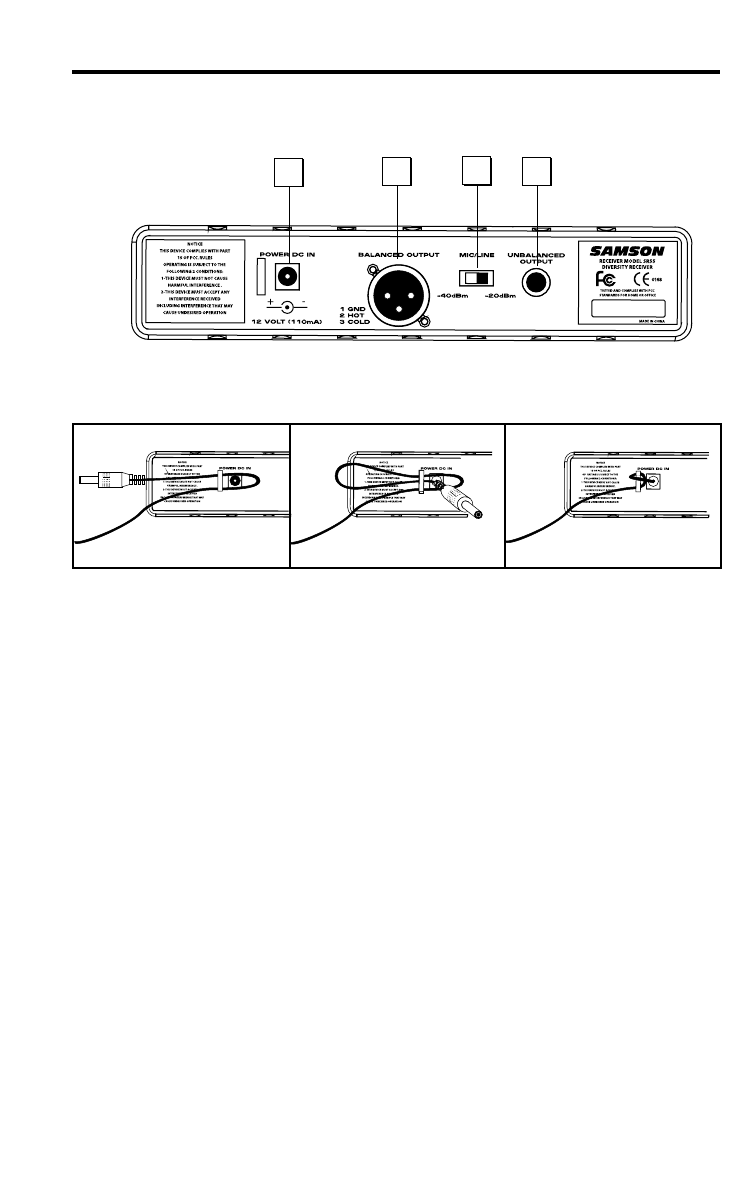
8
Guided Tour - SR5 Rear Panel
1: DC input - Connect the supplied 12 volt, 250 mA power adapter here, using the strain
relief as shown in the illustration below. WARNING: The substitution of any other kind of
power adapter can cause severe damage to the SR5 and will void your warranty.
2: Balanced output* - Use this electronically balanced low impedance (600 Ohm) XLR
jack when connecting the SR5 to professional (+4) audio equipment. Pin wiring is as
follows: Pin 1 ground (shield), Pin 2 high (hot), and Pin 3 low (cold).
3: Audio Output Level switch - Sets the audio output level attenuation of the balanced
output (see #4 below) to -20 dBm (line level) or -40 dBm (mic level). See the “Setting Up
and Using Your Stage 55 Series / Stage 5 Series System” section on page 10 in this man-
ual for more information.
4: Unbalanced output* - Use this unbalanced high impedance (5K Ohm) 1/4" jack when
connecting the SR5 to consumer (-10) audio equipment. Wiring is as follows: tip hot,
sleeve ground.
* If required, both the unbalanced and balanced outputs can be used simultaneously.
1234
-
Using the strain relief: Gather up a loop of wire and pass it through the strain relief,
then pass the adapter plug through the loop in order to create a knot.
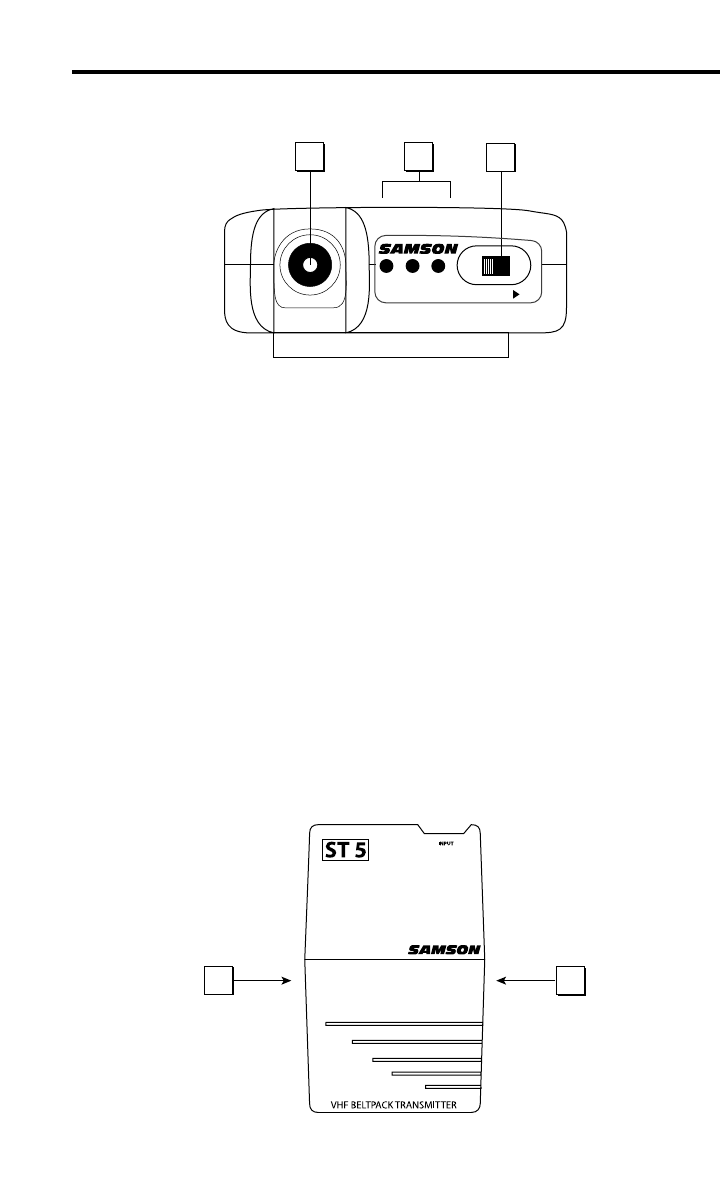
9
Guided Tour - SR5 / ST5
1: Input connector - The input device is connected here. The ST5 is supplied with either
a lavaliere, headset microphone or heavy-duty instrument cable terminating with a 1/4"
plug, which are all connected to the transmitter via a locking 3.5mm mini-phone jack.
2: Battery level meter - This set of three multicolor LEDs indicates relative battery
power, indicating whether the installed battery is at low (red), mid (yellow) or high (green)
strength. One or more of these will light whenever the SR5 or ST5 is powered on (see #5
on the next page). When all three are lit, the battery is at maximum strength. When only
the red “low” indicator lights, RF performance is degraded and the battery needs to be
replaced.
3: Audio on-off switch - When set to the “on” position, audio signal is transmitted.
When set to the “off” position, the audio signal is muted. Because the carrier signal
remains during muting, no “pop” or “thud” will be heard. Note that turning this off does not
turn off the transmitter power—it is simply a way to temporarily mute the transmission of
audio signal. If you don’t plan on using the transmitter for extended periods, turn off the
transmitter power by using the power on-off switch (see #5 on the next page).
4: Battery door release - Press gently inwards on these two indents in order to open the
battery door of the ST5L or ST5 and access the Power on-off switch (see #5 on the next
page) and Gain control (see #6 on the next page).
123
AUDIO ON
LOW MID HIGH
BATTERY LEVEL
4
4
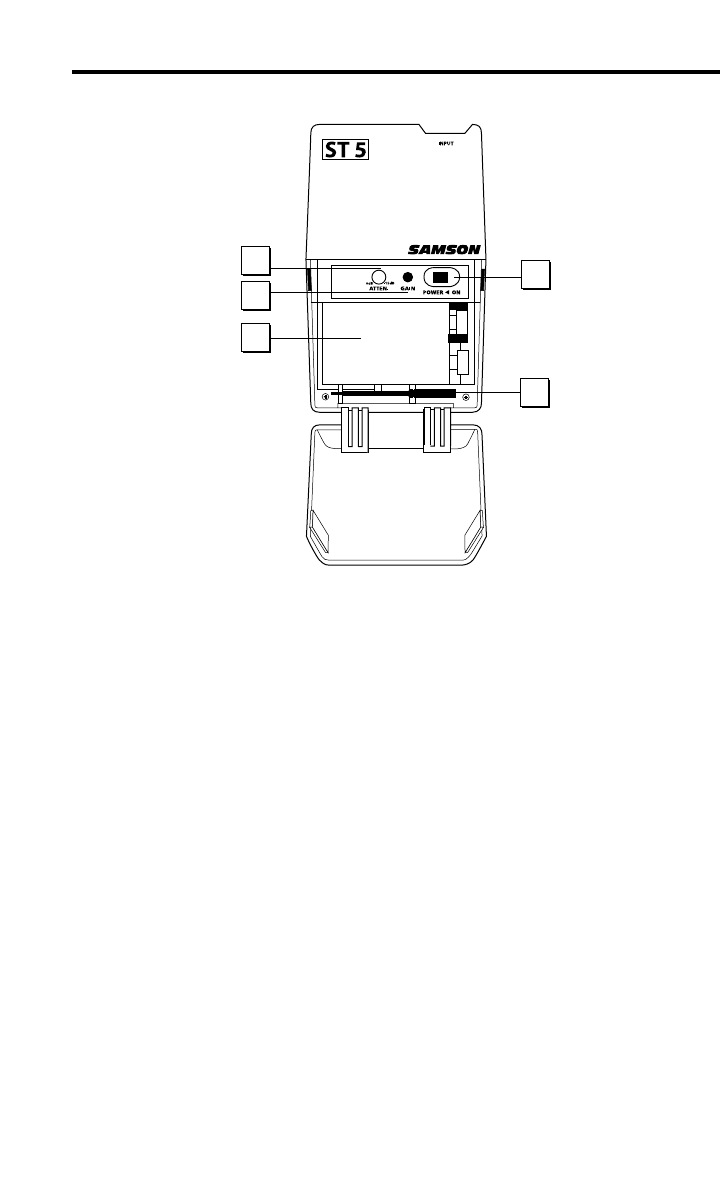
10
Guided Tour - SR5 / ST5
5: Power on-off switch* - Use this to turn the ST5 on or off (to conserve battery power,
be sure to leave it off when not in use).
6: Attenuation switch - The ST5 transmitter features a signal Attenuation switch that is
used to select the input level of “0dB” or “-15dB”. This Attenuation switch has been factory
preset to “0dB” providing the optimum level for most microphone and instrument input sig-
nals. If you are using a microphone or instrument with a high output signal, first try to
adjust the Gain control as described in the following section. If you cannot attenuate the
signal low enough using the Gain control, use the supplied plastic screwdriver (see #9
below) to turn the rotary Attenuation switch to the counter-clockwise position setting the
ST5 to “-15dB” level.
7: Gain control (trimpot) - This input gain control has been factory preset to a nominal
level so we recommend that this be adjusted only if your signal is too high, or too low. If
necessary, however, you can use the supplied plastic screwdriver (see #9 below) to raise
or lower the ST5 Gain control. See the “Setting Up and Using Your Stage 55 Series /
Stage 5 Series System” section on page 12 in this manual for more information.
8: Battery holder - Insert a standard 9-volt alkaline battery here, being sure to observe
the plus and minus polarity markings shown. We recommend the Duracell MN 1604 type
battery. Although rechargeable Ni-Cad batteries can be used, they do not supply adequate
current for more than four hours. WARNING: Do not insert the battery backwards; doing
so can cause severe damage to the ST5 and will void your warranty.
9: Plastic screwdriver - Specially designed for use in adjusting the ST5 Gain control (see
#7 above) and/or receiver Squelch control (see #4 on pages 5 and 7). See the “Setting Up
and Using Your Stage 55 Series / Stage 5 Series System” section on page 12 in this manu-
al for more information.
* Be sure to mute the audio signal at your external mixer or amplifier before turning
transmitter power on or off, or an audible pop may result.
SAMSON 9
8
5
6
7
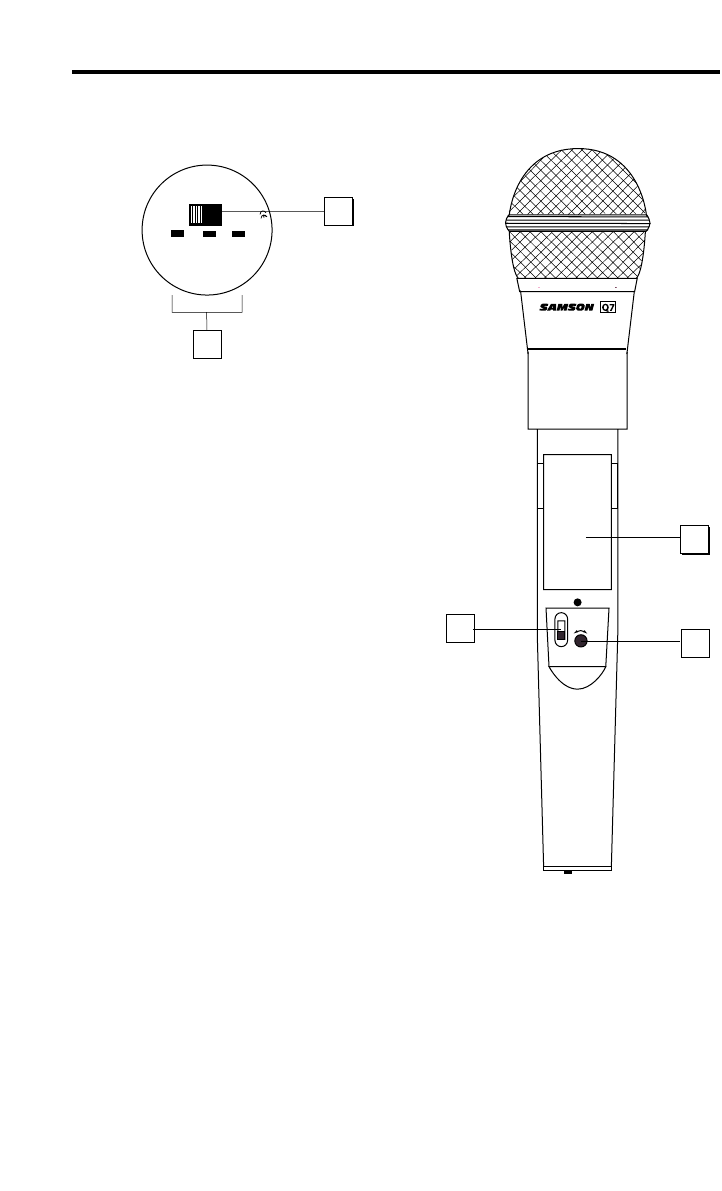
11
Guided Tour - HT5
1: Audio on-off switch - When set to the “on”
position, audio signal is transmitted. When set to
the “off” position, the audio signal is muted.
Because the carrier signal remains during muting,
no “pop” or “thud” will be heard. Note that turning
this off does not turn off the transmitter power—it is
simply a way to temporarily mute the transmission
of audio signal. If you don’t plan on using the HT5
for extended periods, turn off its power by using
the power on-off switch (see #3 below).
2: Battery level meter - This set of three multi-
color LEDs indicates relative battery power, indi-
cating whether the installed battery is at low (red),
mid (yellow) or high (green) strength. One or more
of these will light whenever the HT5 is powered on
(see #3 below). When all three are lit, the battery
is at maximum strength. When only the red “low”
indicator lights, RF performance is degraded and
the battery needs to be replaced.
3: Power on-off switch* - Use this to turn the
HT5 on or off (to conserve battery power, be sure
to leave it off when not in use).
4: Gain control (trimpot) - This input sensitivity
control has been factory preset to provide optimum
level for the particular microphone capsule provid-
ed with your Stage 55 Series or Stage 5 Series system and so we recommend that this
not be adjusted manually. If necessary, however, you can use the supplied plastic screw-
driver to raise or lower the input level. See the “Setting Up and Using Your Stage 55
Series / STAGE 5 Series System” section on page 12 in this manual for more information.
5: Battery holder - Insert a standard 9-volt alkaline battery here, being sure to observe
the plus and minus polarity markings shown. We recommend the Duracell MN 1604 type
battery. Although rechargeable Ni-Cad batteries can be used, they do not supply ade-
quate current for more than four hours. WARNING: Do not insert the battery backwards;
doing so can cause severe damage to the HT5 and will void your warranty.
* Be sure to mute the audio signal at your external mixer or amplifier before turning trans-
mitter power on or off, or an audible pop may result.
MIN MAX
LEVEL
POWER
ON
OFF
5
34
1
AUDIO
LOW MID HIGH
BATTERY LEVEL
Ch2
OFF ON
2
F
C
C
I
D
C
C
R
H
T
5
0
1
6
8

12
Setting Up and Using Your
Stage 55 Series/Stage 5 Series System
The basic procedure for setting up and using your Stage 55 Series or Stage 5 Series
Wireless System takes only a few minutes:
1. For the Stage 55 Series / Stage 5 Series system to work correctly, both the receiver
and transmitter must be set to the same channel. Remove all packing materials (save
them in case of need for future service) and check to make sure that the supplied receiver
and transmitter are set to the same channel. If these channels do not match, contact your
distributor or, if purchased in the United States, Samson Technical Support at
1-800-372-6766.
2. Physically place the receiver where it will be used (the general rule of thumb is to
maintain “line of sight” between the receiver and transmitter so that the person using or
wearing the transmitter can see the receiver). Extend the antenna or antennas and
place them in a vertical position.
3. Make sure the Power on-off switch in your ST5 belt-pack or HT5 handheld transmitter
is set to “Off.”
4a. If your system contains a ST5 belt-pack transmitter, press gently inwards on both
battery cover release indents to open the battery door. Note that this door is hinged and
not intended to be removed from the transmitter case. Please use care when opening this
door as undue force will destroy the hinge.
4b. If your system contains a HT5 handheld transmitter, unscrew the bottom section of
the microphone by turning it counterclockwise and then slide it off.
5. Place a fresh 9-volt alkaline battery in the transmitter battery holder, taking care to
observe the polarity markings. If you are using a ST5 belt-pack transmitter, gently replace
the battery door by swinging it up and pressing until it clicks. If you are using a HT5 hand-
held transmitter, replace the bottom section of the microphone by sliding it on and then
screwing it back on. Whichever transmitter you are using, leave it off for the moment.
6. Make the physical cable connection between the SR55 or SR5 output jack and the line
or mic level audio input of your amplifier or mixer. If you are using the balanced XLR jack
(preferable, since it will deliver an electromagnetically cleaner signal), be sure to set the
receiver rear panel Audio Output Level switch correctly.If required, both the balanced and
unbalanced outputs can be used simultaneously. Leave your amplifier (and/or mixer) off at
this time.
7. Turn the Volume knob on the SR55 or SR5 completely counterclockwise. Using the
strain relief, connect the supplied AC adapter to the DC Input on the rear panel of the
SR55 or SR5, then plug the adapter into any standard AC outlet. Press the front panel
Power switch to turn on the SR55 or SR5; the green “Power” LED will light up, but all other
front panel LEDs will remain unlit.
8. Turn on the power to the ST5 or HT5 transmitter (using its Power on-off switch); all
three Battery strength LEDs will light if the battery is sufficiently strong. At this point, the
RF Meter on the front panel of the receiver will light. If you are using an SR55 receiver,
either the “A” or “B” yellow LED on the front panel will also light, depending upon which
antenna is receiving the stronger signal.

13
Setting Up and Using Your
Stage 55 Series/Stage 5 Series System
9. Now it’s time to set the audio levels. Turn on your connected amplifier and/or mixer but
keep its volume all the way down. Next, make sure that your transmitter is unmuted by
setting its Audio switch to “On.” Then set the Volume knob on the SR55 or SR5 fully
counterclockwise. If you are using the HT5 transmitter or if you are using the ST5 transmit-
ter with a connected lavaliere microphone or headset, speak or sing into the mic at a nor-
mal performance level while observing the SR55 or SR5 front panel Audio Meter. If you are
using the ST5 transmitter with a connected instrument, play the instrument at normal per-
formance level while observing the SR55 or SR5 front panel Audio Meter. If the “0” (unity
gain) segment is lighting steadily, with just occasional higher excursions, the audio level is
correctly set. If not, use the supplied plastic screwdriver to slowly adjust the HT5, or ST5
Gain control (trimpot) until the SR55 or SR5 Audio Meter “0” (unity gain) segment lights
steadily (with occasional higher excursions). Then slowly raise the SR55 or SR5 Volume
knob to the 2 o’clock position (unity gain) and, finally, set the volume of your amplifier/mixer
until the desired level is reached. If you are using a ST5 beltpack transmitter equipped with
a lavaliere microphone, note that correct lavaliere placement is critical to sound quality.
We recommend that you place it as shown in the illustration on the right—as close to your
mouth as possible but off to one side (to minimize
nasality) and unobstructed by clothing. Bear in mind
also that omni microphones (mics which pick up sig-
nal from all directions) are more prone to feedback
problems than unidirectional (cardioid or supercar-
dioid) ones; in general, you can avoid feedback by
taking care not to use any microphone directly in front
of a PA speaker (if this is unavoidable, try using an
equalizer to attenuate those high- or mid-range fre-
quencies which are causing the feedback “squeal-
ing”).
10. If you hear distortion at the desired volume level
(or if the “+6” segment LED in the Audio Meter is
lighting frequently), first check that the SR55 or SR5
rear panel Audio Output Level switch is set correctly.
Next, make sure that the gain structure of your audio
system is correctly set (consult the owners manual of
your mixer and/or amplifier for details). If you still hear distortion, do the following:
•If you are using a HT5 handheld transmitter or an ST5 transmitter with connected
lavaliere microphone or headset, its Gain control has been factory preset to provide
optimum level for the particular microphone model being used and so no adjustment
should be necessary. Any distortion present should therefore simply be a matter of
the microphone being too close to the mouth; try moving it further away. If this does
not solve the problem, use the supplied plastic screwdriver to turn the Gain control
(trimpot) on the HT5 or ST5 slowly counterclockwise until the distortion disappears.
•If you are using a ST5 transmitter with an instrument such as electric guitar or bass,
lower the output level of the instrument until the distortion disappears. Alternatively,
you can use the supplied plastic screwdriver to turn the Gain control (trimpot) on the
ST5 slowly counterclockwise until the distortion disappears.
Note that, following this setup procedure, you can always lower the Volume knob of the
SR55 or SR5 in order to further attenuate the output signal if necessary.

14
Setting Up and Using Your
Stage 55 Series/Stage 5 Series System
11. Conversely, if you hear a weak, noisy signal at the desired volume level (and with the
Volume control of the receiver turned fully clockwise), again make sure that the SR55 or
SR5 rear panel Audio Output Level switch is set correctly and that the gain structure of
your audio system is correctly set. If it is and the signal coming from the SR55 or SR5 is
still weak and/or noisy, do the following:
•If you are using a HT5 transmitter or an ST5 transmitter with connected lavaliere
microphone or headset, its Gain control has been factory preset to provide optimum
level for the particular microphone model being used and so no adjustment should be
necessary. Any weakness of signal should therefore simply be a matter of the
microphone being too far from the mouth; try moving it closer. If this does not solve
the problem, use the supplied plastic screwdriver to turn the Gain control (trimpot) on
the HT5 or ST5 slowly clockwise until the signal reaches an acceptable level.
•If you are using a ST5 transmitter with an instrument such as electric guitar or bass,
raise the output level of the instrument until a good signal is achieved. Alternatively,
you can use the supplied plastic screwdriver to turn the Gain control (trimpot) on the
ST5 slowly clockwise until the signal reaches an acceptable level.
12. Temporarily turn down the level of your mixer/amplifier system and turn off the power
to your transmitter, leaving the SR55 or SR5 on. Then restore the previously set level of
your mixer/amplifier. With the transmitter off, the receiver output should be totally silent—if
it is, skip ahead to the next step. If it isn’t (that is, if you hear some noise), you may need to
adjust the receiver’s front panel Squelch control. When the Squelch control is at its mini-
mum setting, the Stage 55 Series / Stage 5 Series system always provides maximum
range without dropout; however, depending upon the particular environment your system is
used in, you may need to reduce that range somewhat in order to eliminate band noise or
interference when the transmitter is turned off. To do so, use the provided screwdriver to
rotate the Squelch control completely counterclockwise (to the “Min” position), then slowly
turn it clockwise until the noise disappears. If no noise is present at any position, leave it at
its fully counterclockwise “Min” position (so as to have the greatest overall range available).
13. When first setting up the Stage 55 Series or Stage 5 Series System in a new environ-
ment, it’s always a good idea to do a walkaround in order to make sure that coverage is
provided for your entire performance area. Accordingly, turn down the level of your audio
system and turn on both the transmitter and receiver. Then, with the transmitter unmuted,
restore the level of your audio system and while speaking, singing, or playing your instru-
ment, walk through the entire area that will need to be covered. As you do so, the “TX”
LED on the front panel of the SR55 or SR5 should always remain lit. If you are using a
Stage 55 Series system, one of the yellow “A” and “B” LEDs on the SR55 receiver should
always be lit, though occasionally switching to show you which antenna is receiving the
stronger signal. Always try to minimize the distance between transmitter and receiver as
much as possible so that the strongest possible signal is received from all planned trans-
mission points. In fixed installations such as A/V or corporate conference rooms or for
extended range applications (where the transmitter and receiver are more than 150 feet
apart), it may be desirable to angle the receiver antenna or antennas differently from their
vertical position or to install the receiver in the same room as the transmitters (and, if nec-
essary, to extend the wiring to remote audio equipment).
If you have followed all the steps above and are experiencing difficulties, contact your
local distributor or, if purchased in the United States, call Samson Technical Support
(1-800-372-6766) between 9 AM and 5 PM EST.
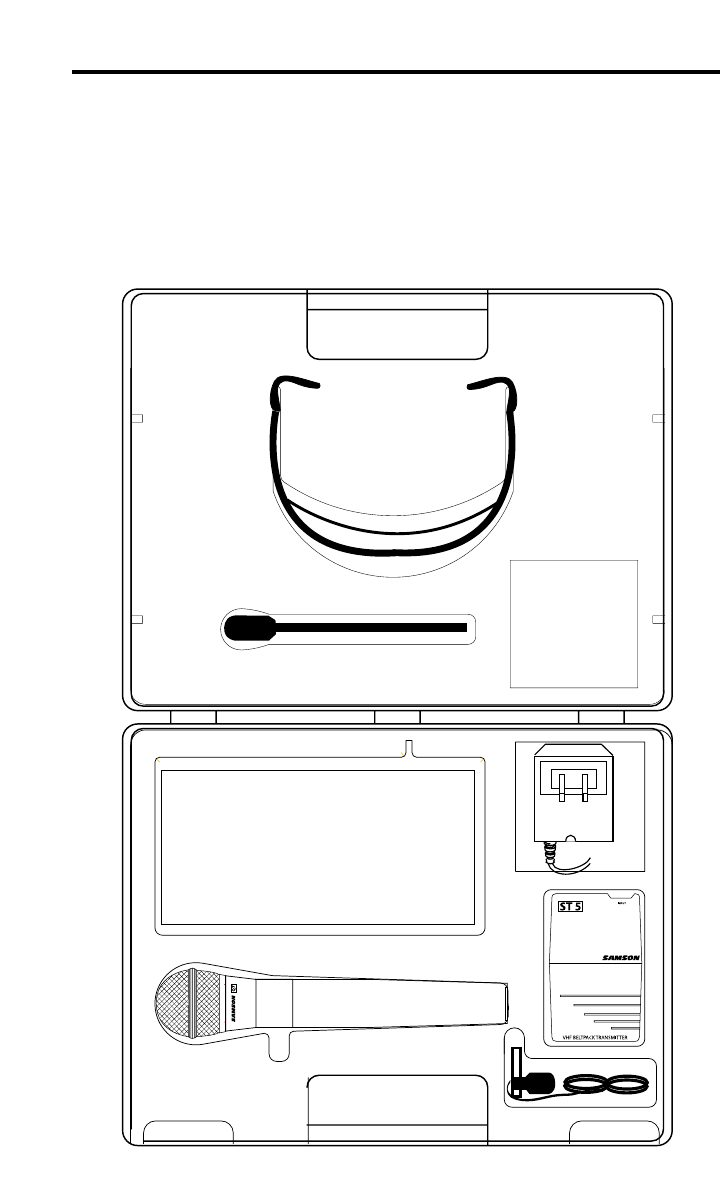
Appendix A: Carrying Case
To ensure the longevity of your Stage 55 Series / Stage 5 Series system, and for conve-
nience when on the road, your Stage 55 Series / Stage 5 Series system includes an
impact-resistant polypropylene plastic carrying case with foam rubber padding. As shown
in the illustration below, custom cutouts in the interior padding provide secure placement
for all components in your system.
15

16
Specifications
Transmitter (ST5 and HT5):
Transmission Mode Frequency modulation, 130KF3E, 15 kHz peak deviation
Frequency Range 174.00 MHz to 216.00 MHz, 25 frequencies
Band A (European / UK models) 160.10 to 177.90 MHz
Band B (European / UK models) 189.10 to 210.10 MHz
OSC System Crystal controlled, x12 multiplication
RF Power 5 mW (USA models), 2 mW (European / UK models)
Operating Range 300 ft.
Frequency Stability ± 10 ppm
Approvals Complies with ETS 300 422 and FCC Part 74
Radiating Harmonic and Spurious Emission Below limits of applicable regulations
Antenna Type Internal
Audio Frequency Response 40 Hz to 15 kHz ±3 dB
Pre-Emphasis 50 µSec
Noise Reduction System NE571 based compandor
Signal To Noise Ratio > 100 dB
Maximum Input Level 0 dBv (ST5), -20 dBv (VH3)
T.H.D. < 1% @ 1 kHz
Current Consumption 34 mA (typical)
Battery Life (MN1604 9-volt alkaline) 6 hours (typical)
Operating Temperature -10 to +55 degrees C
Controls ST5 Power On/Off, Audio On/Off, Attenuation (switch), Level Control (Trimpot)
HT5 Power On/Off, Audio On/Off, Level Control (Trimpot)
LED Indicator Battery high/medium/low
DimensionsST5 65 (W) x 22 (H) x 100 (D) mm (2.6 x .87 x 4 in.)
HT5 37 (W) x 233 (H) mm (1.46 x 9.17 in.)
Weight ST5 100 grams • 3.55 oz.
HT5 200 grams • 7.1 oz.
Receiver SR55 and SR5:
Receiving System
SR55 Single conversion Superheterodyne, Diversity
SR5 Single conversion Superheterodyne, Non-Diversity
Frequency Range 174.00 MHz to 216.00 MHz, 25 frequencies
Band A (European / UK models) 160.10 to 177.90 MHz
Band B (European / UK models) 189.10 to 210.10 MHz
Receiving Mode 130KF3E
Sensitivity < 3 µV for 20 dB SINAD, < 10 µV for 50 dB S/N
Selectivity 120 kHz BW, nominal @ -6 dB, ± 300 kHz (adj CH), -75 dB
Squelch Sensitivity 3 µV to 250 µV adjustable
Intermediate Frequency 10.7 MHz
Local Oscillator System Crystal controlled
Noise Reduction System NE571 based compandor
De-emphasis 50 µsec.
Signal To Noise Ratio > 100 dB (IHF-A) line out, > 90 dB (IHF-A), mic out
Audio Frequency Response 40 Hz to 15 kHz ±3 dB
T.H.D. < 1% @ 1 kHz
Audio Output Levels -10dB unbalanced (1/4" phone connector),
-20 dBm / -40 dBm balanced (XLR connector)
Audio Output Impedance 5 kΩunbalanced, 600 Ωbalanced
Antennas 1/4 wavelength telescopic
Operating Temperature -10 to +55 degrees C
Controls Volume, Squelch, Power
LED Indicators
SR55 Antenna A or B (2 LEDs) /AF Level (6 LEDs) / RF Level (6 LEDs)
SR5 TX On / AF Level (6 LEDs) / RF Level (6 LEDs)
Power Requirement 12 Volts DC, 100 mA typical (110 mA max.), AC adapter supplied
Dimensions (W x H x D, without antennas) 216 x 44 x 116 mm (8.5 x 1.75 x 4.6 in.)
Weight (including antennas) 20 g • 0.75 lb

FCC Rules and Regulations
Samson wireless systems are type accepted under
FCC rules parts 74 and 15.
Licensing of Samson equipment is the user’s
responsibility and licensability depends on the user’s
classification, application and frequency selected.
This device complies with RSS-210 of
Industry & Science Canada.
Operation is subject to the following two conditions:
(1) this device may not cause harmful interference
and (2) this device must accept any interference
received, including interference that may cause
undesired operation.
Caution:
Any modification to the equipment not
expressively authorized by the party
responsible for compliance could void the
users's authority to operate the equipment.